Value Creation and Organizational Analysis of All Seasons Business
VerifiedAdded on 2022/09/30
|11
|2401
|24
Report
AI Summary
This report provides a comprehensive analysis of All Seasons, a business specializing in knitted woollen clothes. It delves into the company's value creation strategies, emphasizing quality, sustainability, and a low-cost model. The report examines how All Seasons creates value for its customers through sustainable practices, an efficient supply chain, and effective distribution. It identifies key dimensions supporting the value proposition, including the role of management, strategic management practices, and organizational structure. The analysis includes a value creation chart and an organizational structure diagram, highlighting the roles of different departments and stakeholders. The report also identifies and discusses the internal and external stakeholders of the business, including employees, suppliers, shareholders, and society, and how All Seasons addresses their needs. Finally, it applies organizational theory, specifically the modern theory of organizational management, to the business structure of All Seasons, emphasizing its focus on growth, environmental standards, and cost-effectiveness. The report concludes by referencing relevant academic sources.
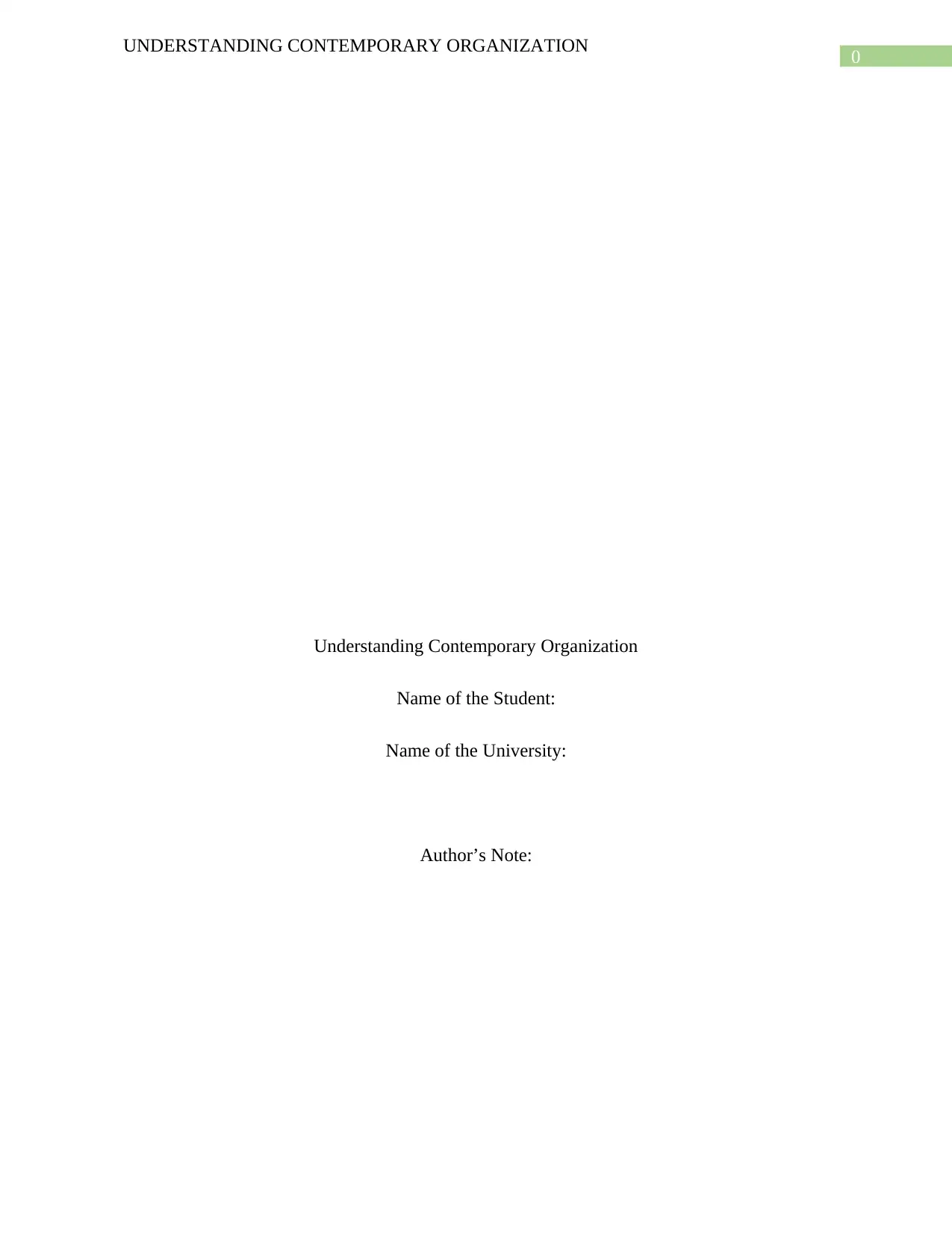
0
UNDERSTANDING CONTEMPORARY ORGANIZATION
Understanding Contemporary Organization
Name of the Student:
Name of the University:
Author’s Note:
UNDERSTANDING CONTEMPORARY ORGANIZATION
Understanding Contemporary Organization
Name of the Student:
Name of the University:
Author’s Note:
Paraphrase This Document
Need a fresh take? Get an instant paraphrase of this document with our AI Paraphraser

1
UNDERSTANDING CONTEMPORARY ORGANIZATION
Introduction
The main purpose of the assessment is to analyse the business of All Seasons which is
engaged in the business of providing Knitted woollen clothes and meet the garment needs of the
clients. The assessment would be shedding light on how the business creates values for its
customers. The management of the company provides more emphasis on quality and thereby
takes every effort to maintain quality as this would allow the business to attract more customers.
The greatest advantage of the business is that the management has already blended sustainability
in its operational process (Schaltegger, Hansen and Lüdeke-Freund 2016). The discussion would
be revolving around the main processes and dimension which is considered by the business and
also identify the key stakeholders of the company. The discussion would also be including key
organizational theories in the management of the company.
Creation of Value
The business of All Seasons is dedicated to maintain quality in the products produced by
the company. One of the core values of the business is to maintain quality of products and
engage in sustainable procedures for conducting operations of the business. This is done in order
to ensure that proper quality is maintained and no harm is caused to the ecology due to the
activities of the business. The company has the policy of using the wool of the best quality from
different area of Australia. The company has contracts with regenerative farmers who are also
following sustainable practices so that the quality of the products and the policy of the business
of sustainable management is maintained. The business also has an effective supply chain
process which allows the management to conduct different activities which produces garments in
an efficient manner. The business also has the best cutting and sewing machines which allows
the business to produce the best quality of woollen products for the customers (Formentini and
UNDERSTANDING CONTEMPORARY ORGANIZATION
Introduction
The main purpose of the assessment is to analyse the business of All Seasons which is
engaged in the business of providing Knitted woollen clothes and meet the garment needs of the
clients. The assessment would be shedding light on how the business creates values for its
customers. The management of the company provides more emphasis on quality and thereby
takes every effort to maintain quality as this would allow the business to attract more customers.
The greatest advantage of the business is that the management has already blended sustainability
in its operational process (Schaltegger, Hansen and Lüdeke-Freund 2016). The discussion would
be revolving around the main processes and dimension which is considered by the business and
also identify the key stakeholders of the company. The discussion would also be including key
organizational theories in the management of the company.
Creation of Value
The business of All Seasons is dedicated to maintain quality in the products produced by
the company. One of the core values of the business is to maintain quality of products and
engage in sustainable procedures for conducting operations of the business. This is done in order
to ensure that proper quality is maintained and no harm is caused to the ecology due to the
activities of the business. The company has the policy of using the wool of the best quality from
different area of Australia. The company has contracts with regenerative farmers who are also
following sustainable practices so that the quality of the products and the policy of the business
of sustainable management is maintained. The business also has an effective supply chain
process which allows the management to conduct different activities which produces garments in
an efficient manner. The business also has the best cutting and sewing machines which allows
the business to produce the best quality of woollen products for the customers (Formentini and

2
UNDERSTANDING CONTEMPORARY ORGANIZATION
Taticchi 2016). If any fabric remains after the process of garment production then the same is
send to be reused as an organic fertilizer and the same is developed by an organic composter.
This ensures that there is zero wastage of resources of the business (Seuring and Gold 2013). In
this process, the business is able to create garments from mere wool and thereby also create
value. In addition to this, All Seasons also have an effective distribution system which creates
place utility and allows the business to serve many customers in a single period.
Key Dimension to Support Value Proposition
The role of the management of the company is very important in supporting the value
proposition of the business and also ensure that the business is able to generate appropriate
revenue from operational process. The key factor of value proposition for a business which needs
to be supported is that it enhances the value of the customers and also increase the revenue of the
company. The senior management of the company are responsible for taking all the major
decisions relating to the business (Evans et al. 2017). The management of the company focuses
on enhancing the revenue of the business but at the same time maintain sustainability in its
approach. The business follows strategic management practices so that the organizational values
and practices are appropriately followed in the business. The business also looks to develop its
operational structure for enhancing the efficiency of the business. The business structure
effectively allows the business to maintain small group of employees but the employee needs to
have the necessary skills for which proper training is provided to all the employee of the business
(Shafritz, Ott and Jang 2015). The management of the company wants to enhance the skills of
the employee so that they can be more efficient. In order to show the value creation of the
business, a value creation chart is effectively shown below:
UNDERSTANDING CONTEMPORARY ORGANIZATION
Taticchi 2016). If any fabric remains after the process of garment production then the same is
send to be reused as an organic fertilizer and the same is developed by an organic composter.
This ensures that there is zero wastage of resources of the business (Seuring and Gold 2013). In
this process, the business is able to create garments from mere wool and thereby also create
value. In addition to this, All Seasons also have an effective distribution system which creates
place utility and allows the business to serve many customers in a single period.
Key Dimension to Support Value Proposition
The role of the management of the company is very important in supporting the value
proposition of the business and also ensure that the business is able to generate appropriate
revenue from operational process. The key factor of value proposition for a business which needs
to be supported is that it enhances the value of the customers and also increase the revenue of the
company. The senior management of the company are responsible for taking all the major
decisions relating to the business (Evans et al. 2017). The management of the company focuses
on enhancing the revenue of the business but at the same time maintain sustainability in its
approach. The business follows strategic management practices so that the organizational values
and practices are appropriately followed in the business. The business also looks to develop its
operational structure for enhancing the efficiency of the business. The business structure
effectively allows the business to maintain small group of employees but the employee needs to
have the necessary skills for which proper training is provided to all the employee of the business
(Shafritz, Ott and Jang 2015). The management of the company wants to enhance the skills of
the employee so that they can be more efficient. In order to show the value creation of the
business, a value creation chart is effectively shown below:
⊘ This is a preview!⊘
Do you want full access?
Subscribe today to unlock all pages.

Trusted by 1+ million students worldwide
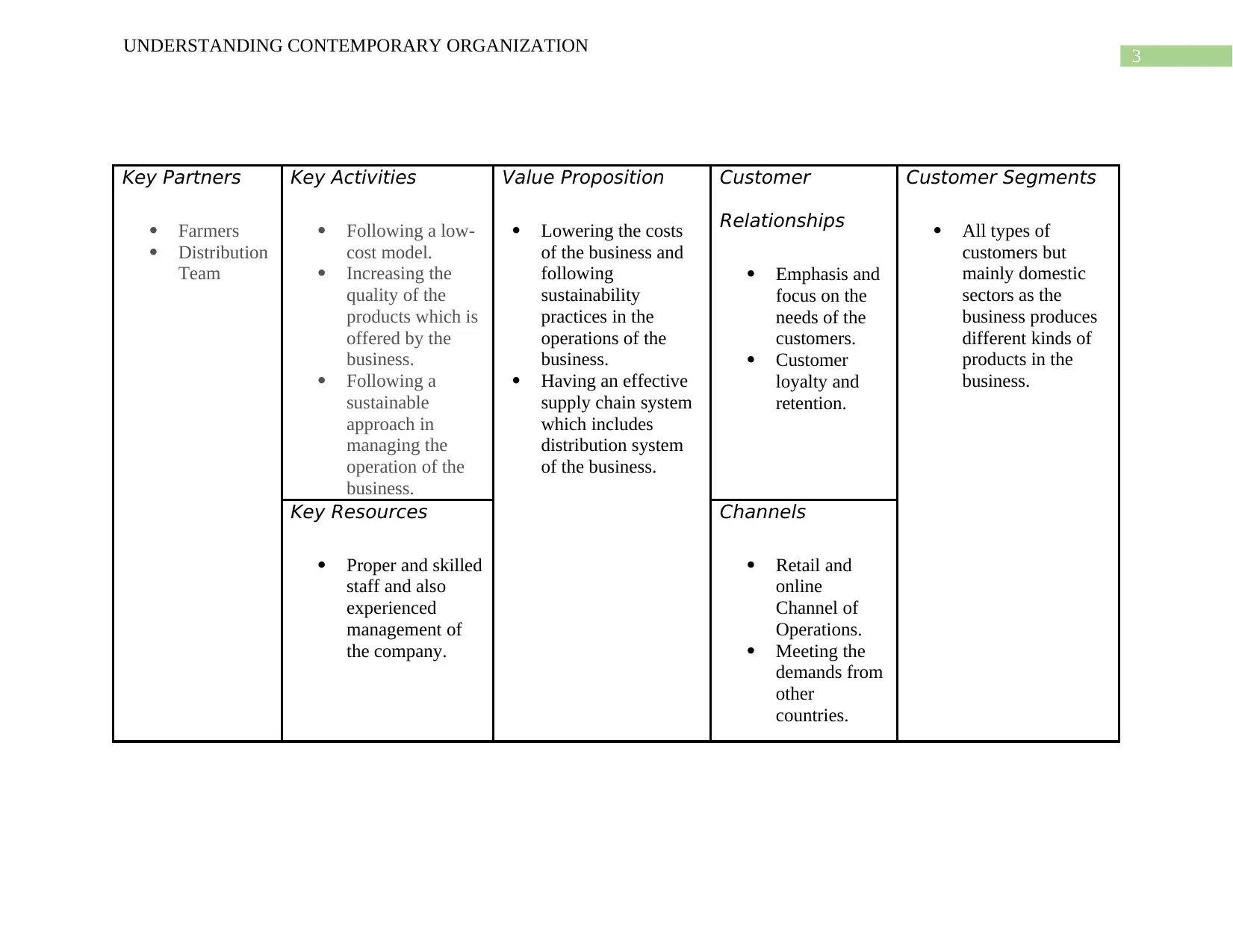
3
UNDERSTANDING CONTEMPORARY ORGANIZATION
Key Partners
Farmers
Distribution
Team
Key Activities
Following a low-
cost model.
Increasing the
quality of the
products which is
offered by the
business.
Following a
sustainable
approach in
managing the
operation of the
business.
Value Proposition
Lowering the costs
of the business and
following
sustainability
practices in the
operations of the
business.
Having an effective
supply chain system
which includes
distribution system
of the business.
Customer
Relationships
Emphasis and
focus on the
needs of the
customers.
Customer
loyalty and
retention.
Customer Segments
All types of
customers but
mainly domestic
sectors as the
business produces
different kinds of
products in the
business.
Key Resources
Proper and skilled
staff and also
experienced
management of
the company.
Channels
Retail and
online
Channel of
Operations.
Meeting the
demands from
other
countries.
UNDERSTANDING CONTEMPORARY ORGANIZATION
Key Partners
Farmers
Distribution
Team
Key Activities
Following a low-
cost model.
Increasing the
quality of the
products which is
offered by the
business.
Following a
sustainable
approach in
managing the
operation of the
business.
Value Proposition
Lowering the costs
of the business and
following
sustainability
practices in the
operations of the
business.
Having an effective
supply chain system
which includes
distribution system
of the business.
Customer
Relationships
Emphasis and
focus on the
needs of the
customers.
Customer
loyalty and
retention.
Customer Segments
All types of
customers but
mainly domestic
sectors as the
business produces
different kinds of
products in the
business.
Key Resources
Proper and skilled
staff and also
experienced
management of
the company.
Channels
Retail and
online
Channel of
Operations.
Meeting the
demands from
other
countries.
Paraphrase This Document
Need a fresh take? Get an instant paraphrase of this document with our AI Paraphraser
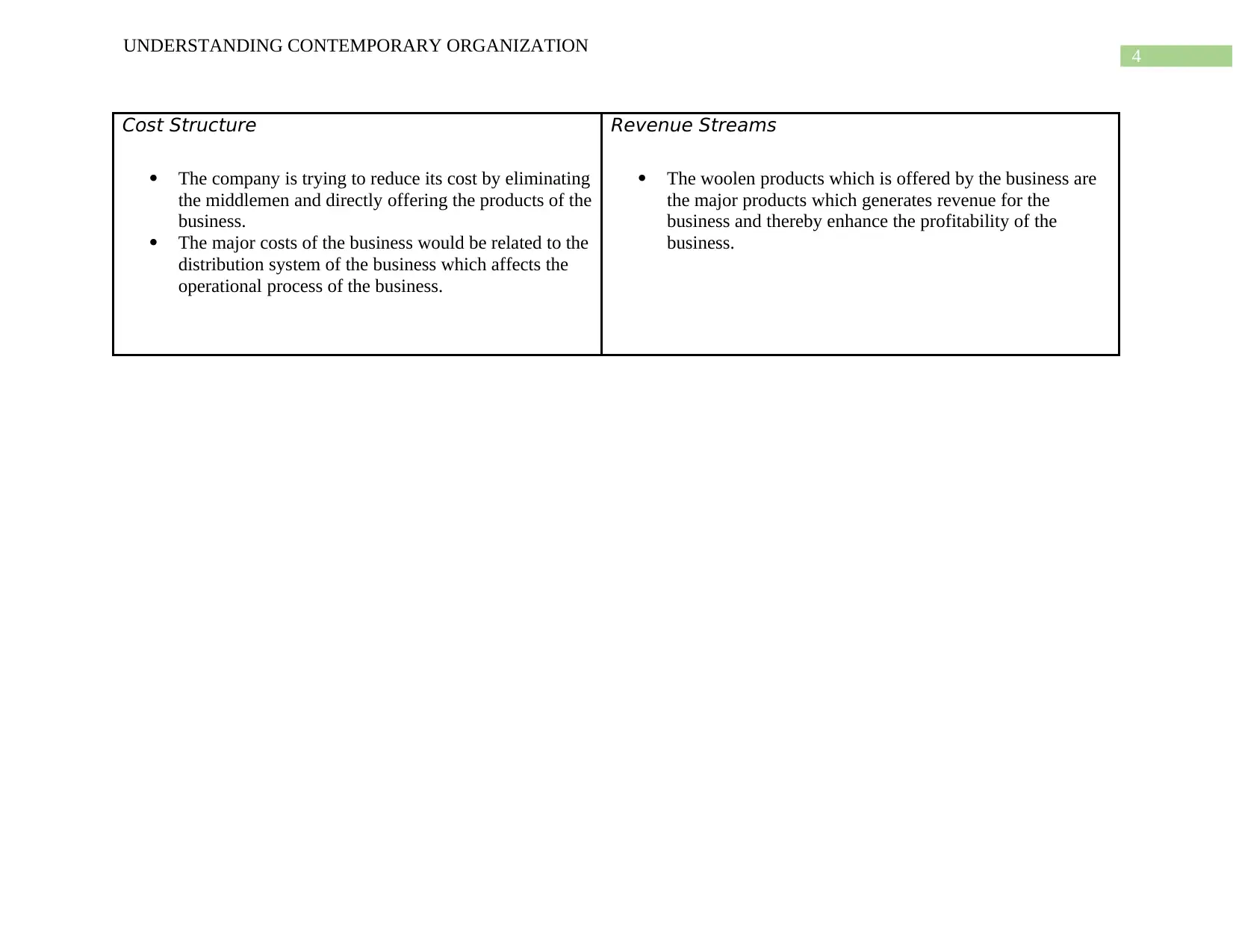
4
UNDERSTANDING CONTEMPORARY ORGANIZATION
Cost Structure
The company is trying to reduce its cost by eliminating
the middlemen and directly offering the products of the
business.
The major costs of the business would be related to the
distribution system of the business which affects the
operational process of the business.
Revenue Streams
The woolen products which is offered by the business are
the major products which generates revenue for the
business and thereby enhance the profitability of the
business.
UNDERSTANDING CONTEMPORARY ORGANIZATION
Cost Structure
The company is trying to reduce its cost by eliminating
the middlemen and directly offering the products of the
business.
The major costs of the business would be related to the
distribution system of the business which affects the
operational process of the business.
Revenue Streams
The woolen products which is offered by the business are
the major products which generates revenue for the
business and thereby enhance the profitability of the
business.
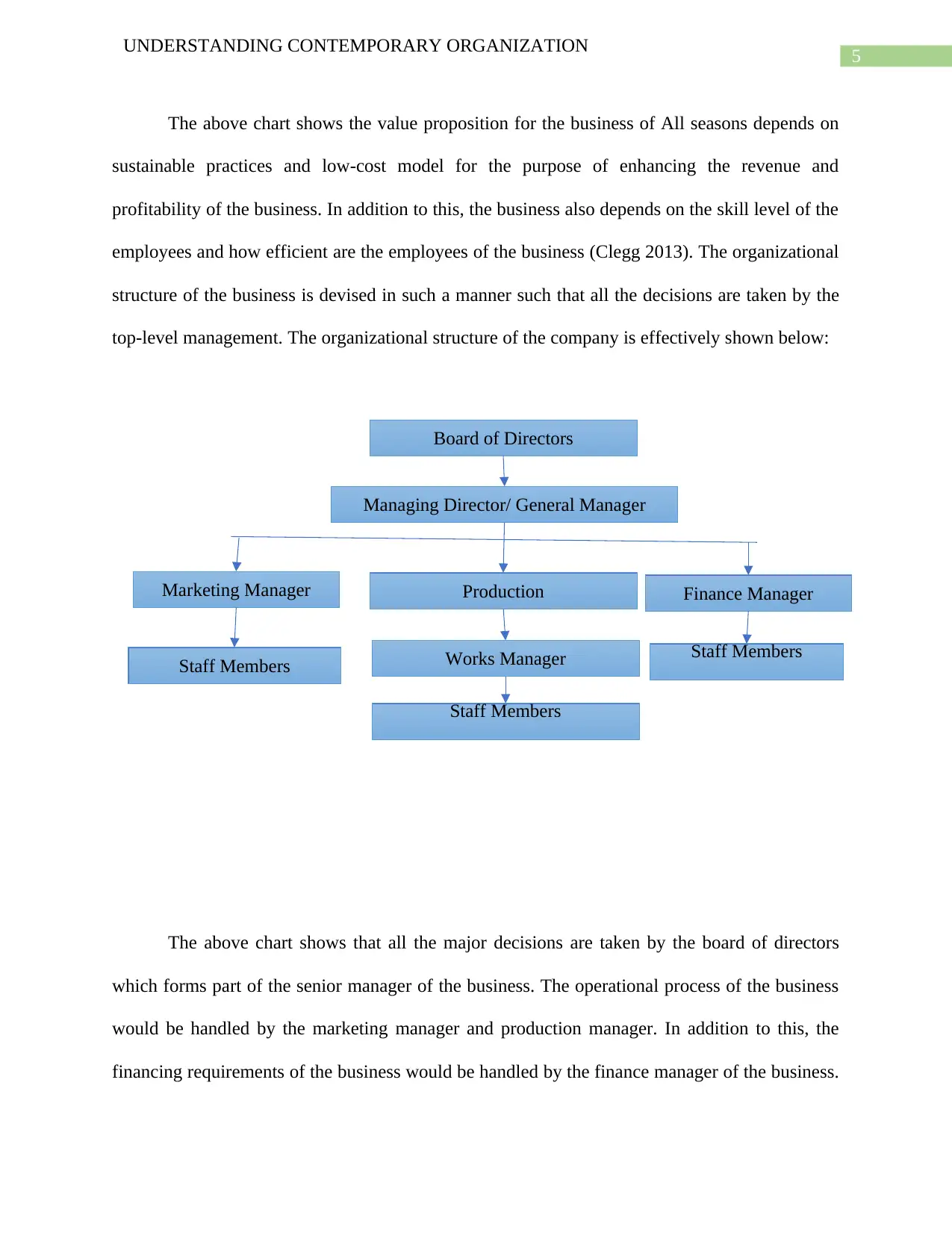
Board of Directors
Managing Director/ General Manager
Production
Works Manager
Staff Members
Staff Members
Staff Members
Marketing Manager Finance Manager
5
UNDERSTANDING CONTEMPORARY ORGANIZATION
The above chart shows the value proposition for the business of All seasons depends on
sustainable practices and low-cost model for the purpose of enhancing the revenue and
profitability of the business. In addition to this, the business also depends on the skill level of the
employees and how efficient are the employees of the business (Clegg 2013). The organizational
structure of the business is devised in such a manner such that all the decisions are taken by the
top-level management. The organizational structure of the company is effectively shown below:
The above chart shows that all the major decisions are taken by the board of directors
which forms part of the senior manager of the business. The operational process of the business
would be handled by the marketing manager and production manager. In addition to this, the
financing requirements of the business would be handled by the finance manager of the business.
Managing Director/ General Manager
Production
Works Manager
Staff Members
Staff Members
Staff Members
Marketing Manager Finance Manager
5
UNDERSTANDING CONTEMPORARY ORGANIZATION
The above chart shows the value proposition for the business of All seasons depends on
sustainable practices and low-cost model for the purpose of enhancing the revenue and
profitability of the business. In addition to this, the business also depends on the skill level of the
employees and how efficient are the employees of the business (Clegg 2013). The organizational
structure of the business is devised in such a manner such that all the decisions are taken by the
top-level management. The organizational structure of the company is effectively shown below:
The above chart shows that all the major decisions are taken by the board of directors
which forms part of the senior manager of the business. The operational process of the business
would be handled by the marketing manager and production manager. In addition to this, the
financing requirements of the business would be handled by the finance manager of the business.
⊘ This is a preview!⊘
Do you want full access?
Subscribe today to unlock all pages.

Trusted by 1+ million students worldwide
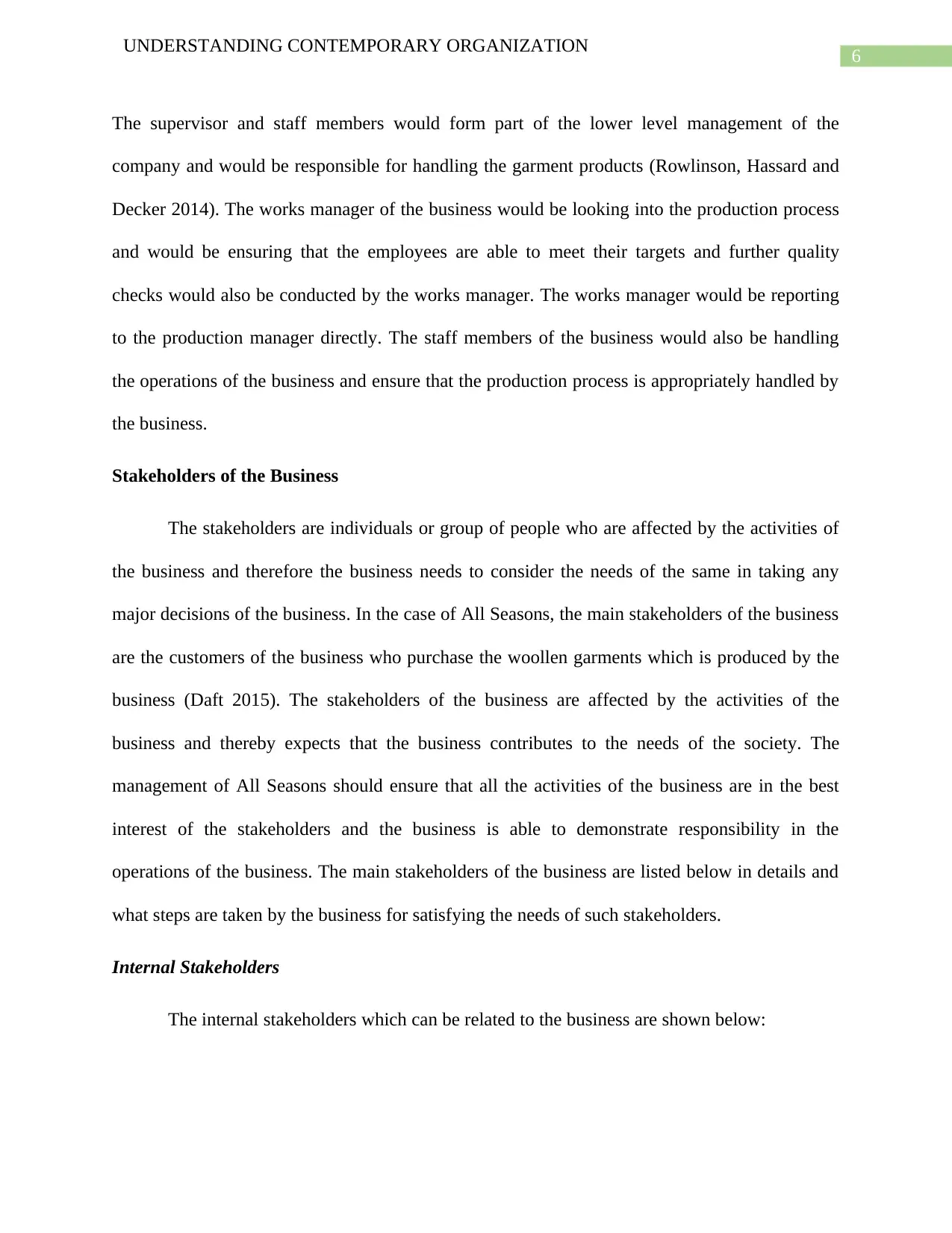
6
UNDERSTANDING CONTEMPORARY ORGANIZATION
The supervisor and staff members would form part of the lower level management of the
company and would be responsible for handling the garment products (Rowlinson, Hassard and
Decker 2014). The works manager of the business would be looking into the production process
and would be ensuring that the employees are able to meet their targets and further quality
checks would also be conducted by the works manager. The works manager would be reporting
to the production manager directly. The staff members of the business would also be handling
the operations of the business and ensure that the production process is appropriately handled by
the business.
Stakeholders of the Business
The stakeholders are individuals or group of people who are affected by the activities of
the business and therefore the business needs to consider the needs of the same in taking any
major decisions of the business. In the case of All Seasons, the main stakeholders of the business
are the customers of the business who purchase the woollen garments which is produced by the
business (Daft 2015). The stakeholders of the business are affected by the activities of the
business and thereby expects that the business contributes to the needs of the society. The
management of All Seasons should ensure that all the activities of the business are in the best
interest of the stakeholders and the business is able to demonstrate responsibility in the
operations of the business. The main stakeholders of the business are listed below in details and
what steps are taken by the business for satisfying the needs of such stakeholders.
Internal Stakeholders
The internal stakeholders which can be related to the business are shown below:
UNDERSTANDING CONTEMPORARY ORGANIZATION
The supervisor and staff members would form part of the lower level management of the
company and would be responsible for handling the garment products (Rowlinson, Hassard and
Decker 2014). The works manager of the business would be looking into the production process
and would be ensuring that the employees are able to meet their targets and further quality
checks would also be conducted by the works manager. The works manager would be reporting
to the production manager directly. The staff members of the business would also be handling
the operations of the business and ensure that the production process is appropriately handled by
the business.
Stakeholders of the Business
The stakeholders are individuals or group of people who are affected by the activities of
the business and therefore the business needs to consider the needs of the same in taking any
major decisions of the business. In the case of All Seasons, the main stakeholders of the business
are the customers of the business who purchase the woollen garments which is produced by the
business (Daft 2015). The stakeholders of the business are affected by the activities of the
business and thereby expects that the business contributes to the needs of the society. The
management of All Seasons should ensure that all the activities of the business are in the best
interest of the stakeholders and the business is able to demonstrate responsibility in the
operations of the business. The main stakeholders of the business are listed below in details and
what steps are taken by the business for satisfying the needs of such stakeholders.
Internal Stakeholders
The internal stakeholders which can be related to the business are shown below:
Paraphrase This Document
Need a fresh take? Get an instant paraphrase of this document with our AI Paraphraser

7
UNDERSTANDING CONTEMPORARY ORGANIZATION
Employees: The employees are one of the main internal stakeholders of the business and has a
big impact on the performance of the business. The business of All Seasons has small employee
force but the same are efficient which plays a vital role in generation of revenue. The employee
plays an important role in creation of value for the customers.
Suppliers: The suppliers of the business are also one of the major stakeholders of the business as
they supply the resources from which the final output is produced (Burke 2017). The
management of All Seasons uses farmers who uses sustainable practices for providing raw wool
which is used by business for producing garments. The farmers provide the best quality wool on
the basis which garments are created which shows that the value is created in the initial stages
itself.
External Stakeholders
The external stakeholders are also important consideration which needs to be considered
by a business before taking any major decision relating to the business. Some of the external
stakeholders which can be identified are discussed below:
Shareholders: The shareholders are major stakeholders as the invest in the operations of the
business and are basically treated as the owners of the business. The business can make
contributions to their needs by earning profits or increasing market share. The management of
the company ensures that the costs of the products are kept low so that the same can be afforded
by everyone.
Society: The general society is also a stakeholder of the business and therefore the business is
responsible to the needs of the society. The management of the company puts more emphasis on
Corporate social responsibility of the business (Miller and Power 2013). The business puts more
UNDERSTANDING CONTEMPORARY ORGANIZATION
Employees: The employees are one of the main internal stakeholders of the business and has a
big impact on the performance of the business. The business of All Seasons has small employee
force but the same are efficient which plays a vital role in generation of revenue. The employee
plays an important role in creation of value for the customers.
Suppliers: The suppliers of the business are also one of the major stakeholders of the business as
they supply the resources from which the final output is produced (Burke 2017). The
management of All Seasons uses farmers who uses sustainable practices for providing raw wool
which is used by business for producing garments. The farmers provide the best quality wool on
the basis which garments are created which shows that the value is created in the initial stages
itself.
External Stakeholders
The external stakeholders are also important consideration which needs to be considered
by a business before taking any major decision relating to the business. Some of the external
stakeholders which can be identified are discussed below:
Shareholders: The shareholders are major stakeholders as the invest in the operations of the
business and are basically treated as the owners of the business. The business can make
contributions to their needs by earning profits or increasing market share. The management of
the company ensures that the costs of the products are kept low so that the same can be afforded
by everyone.
Society: The general society is also a stakeholder of the business and therefore the business is
responsible to the needs of the society. The management of the company puts more emphasis on
Corporate social responsibility of the business (Miller and Power 2013). The business puts more

8
UNDERSTANDING CONTEMPORARY ORGANIZATION
emphasis on sustainability practices in operations so that no activity of the business affects the
environment in adverse manner. The business needs to contribute to the needs of the society and
appropriately work for the welfare of the society.
Application of Organizational Theory
The analysis of the business structure of All Seasons reveals that the business is able to
enhance the value of the products which would help the business to enhance the profitability of
the business. The business model which is followed by the company is the modern theory of
organizational management (Fineman, Gabriel and Sims 2009). As per the modern theory, the
business needs to formulate an approach which is systematic in nature and should have a
contingency approach in case the business does not perform up to the expectation of the
management. There are numerous actors which can have an impact on a business and some of
these may be internal while some maybe external in nature. In such a structure, the organization
structure is divided into subsystems which defines the roles of different areas of the business. In
the case of contingency approach, the structure of a business which is suitable for one business
may not be appropriate for another business. In addition to this, the theory also states that the
organizational structure of a business is also affected by internal and external factors and
therefore the same should be considered in taking major decisions for the business.
The operational structure of All Season follows Modern theory of organizational
management as the emphasis is on growth while maintaining environmental standards and
sustainability in the operational process. The business of All seasons also focuses on following a
low-cost model so that more and more customers are attracted to the business. In this manner as
well, the business also creates values for the customers for the long run. The business of All
UNDERSTANDING CONTEMPORARY ORGANIZATION
emphasis on sustainability practices in operations so that no activity of the business affects the
environment in adverse manner. The business needs to contribute to the needs of the society and
appropriately work for the welfare of the society.
Application of Organizational Theory
The analysis of the business structure of All Seasons reveals that the business is able to
enhance the value of the products which would help the business to enhance the profitability of
the business. The business model which is followed by the company is the modern theory of
organizational management (Fineman, Gabriel and Sims 2009). As per the modern theory, the
business needs to formulate an approach which is systematic in nature and should have a
contingency approach in case the business does not perform up to the expectation of the
management. There are numerous actors which can have an impact on a business and some of
these may be internal while some maybe external in nature. In such a structure, the organization
structure is divided into subsystems which defines the roles of different areas of the business. In
the case of contingency approach, the structure of a business which is suitable for one business
may not be appropriate for another business. In addition to this, the theory also states that the
organizational structure of a business is also affected by internal and external factors and
therefore the same should be considered in taking major decisions for the business.
The operational structure of All Season follows Modern theory of organizational
management as the emphasis is on growth while maintaining environmental standards and
sustainability in the operational process. The business of All seasons also focuses on following a
low-cost model so that more and more customers are attracted to the business. In this manner as
well, the business also creates values for the customers for the long run. The business of All
⊘ This is a preview!⊘
Do you want full access?
Subscribe today to unlock all pages.

Trusted by 1+ million students worldwide

9
UNDERSTANDING CONTEMPORARY ORGANIZATION
Seasons effectively allows the management of the company to effectively conduct the operations
of the business generate revenues for further growth and development of the business.
Reference
Burke, W.W., 2017. Organization change: Theory and practice. Sage Publications.
Clegg, S., 2013. The Theory of Power and Organization (RLE: Organizations). Routledge.
Daft, R.L., 2015. Organization theory and design. Cengage learning.
Evans, S., Vladimirova, D., Holgado, M., Van Fossen, K., Yang, M., Silva, E.A. and Barlow,
C.Y., 2017. Business model innovation for sustainability: Towards a unified perspective for
creation of sustainable business models. Business Strategy and the Environment, 26(5), pp.597-
608.
Formentini, M. and Taticchi, P., 2016. Corporate sustainability approaches and governance
mechanisms in sustainable supply chain management. Journal of Cleaner Production, 112,
pp.1920-1933.
Miller, P. and Power, M., 2013. Accounting, organizing, and economizing: Connecting
accounting research and organization theory. The Academy of Management Annals, 7(1), pp.557-
605.
Rowlinson, M., Hassard, J. and Decker, S., 2014. Research strategies for organizational history:
A dialogue between historical theory and organization theory. Academy of Management
Review, 39(3), pp.250-274.
UNDERSTANDING CONTEMPORARY ORGANIZATION
Seasons effectively allows the management of the company to effectively conduct the operations
of the business generate revenues for further growth and development of the business.
Reference
Burke, W.W., 2017. Organization change: Theory and practice. Sage Publications.
Clegg, S., 2013. The Theory of Power and Organization (RLE: Organizations). Routledge.
Daft, R.L., 2015. Organization theory and design. Cengage learning.
Evans, S., Vladimirova, D., Holgado, M., Van Fossen, K., Yang, M., Silva, E.A. and Barlow,
C.Y., 2017. Business model innovation for sustainability: Towards a unified perspective for
creation of sustainable business models. Business Strategy and the Environment, 26(5), pp.597-
608.
Formentini, M. and Taticchi, P., 2016. Corporate sustainability approaches and governance
mechanisms in sustainable supply chain management. Journal of Cleaner Production, 112,
pp.1920-1933.
Miller, P. and Power, M., 2013. Accounting, organizing, and economizing: Connecting
accounting research and organization theory. The Academy of Management Annals, 7(1), pp.557-
605.
Rowlinson, M., Hassard, J. and Decker, S., 2014. Research strategies for organizational history:
A dialogue between historical theory and organization theory. Academy of Management
Review, 39(3), pp.250-274.
Paraphrase This Document
Need a fresh take? Get an instant paraphrase of this document with our AI Paraphraser
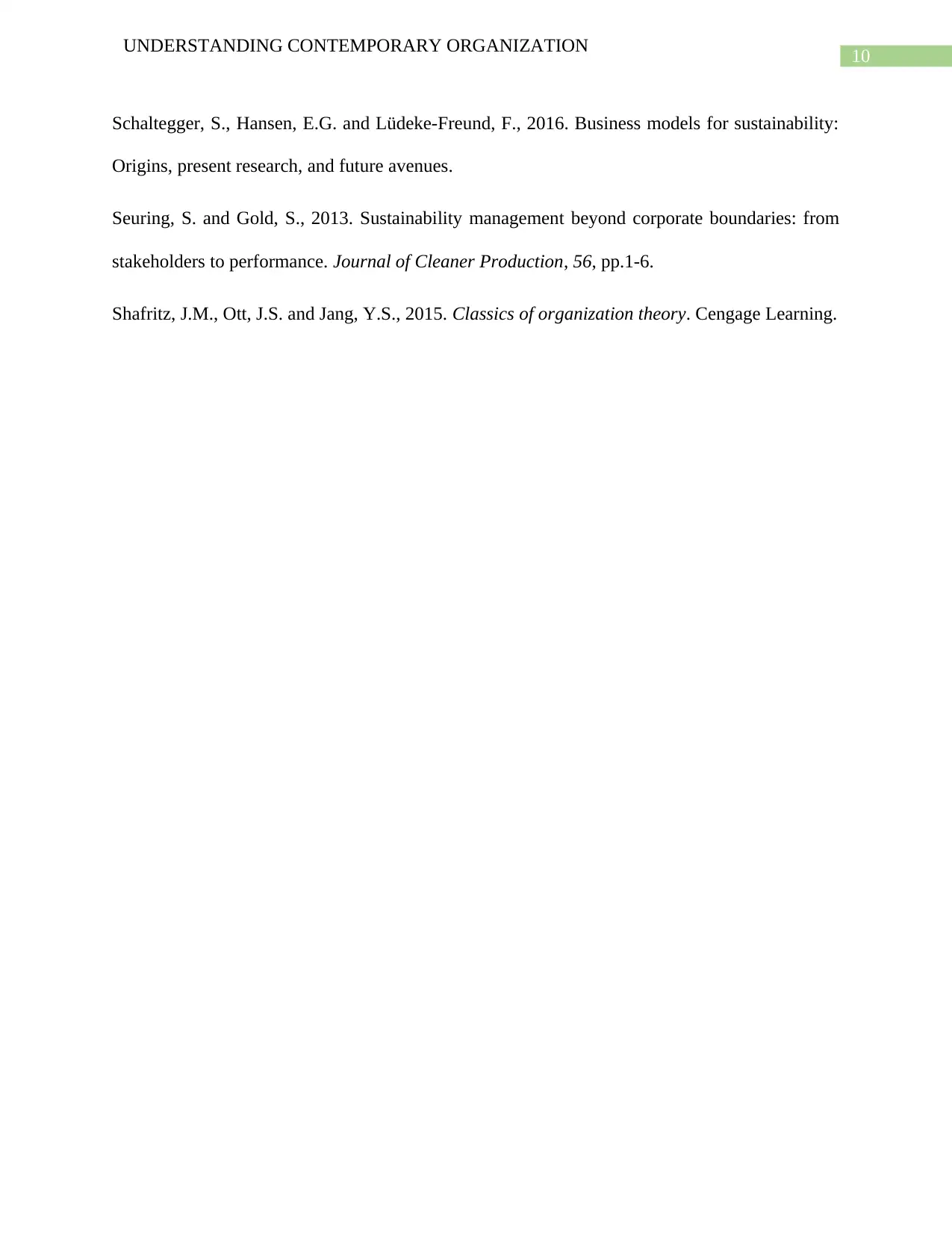
10
UNDERSTANDING CONTEMPORARY ORGANIZATION
Schaltegger, S., Hansen, E.G. and Lüdeke-Freund, F., 2016. Business models for sustainability:
Origins, present research, and future avenues.
Seuring, S. and Gold, S., 2013. Sustainability management beyond corporate boundaries: from
stakeholders to performance. Journal of Cleaner Production, 56, pp.1-6.
Shafritz, J.M., Ott, J.S. and Jang, Y.S., 2015. Classics of organization theory. Cengage Learning.
UNDERSTANDING CONTEMPORARY ORGANIZATION
Schaltegger, S., Hansen, E.G. and Lüdeke-Freund, F., 2016. Business models for sustainability:
Origins, present research, and future avenues.
Seuring, S. and Gold, S., 2013. Sustainability management beyond corporate boundaries: from
stakeholders to performance. Journal of Cleaner Production, 56, pp.1-6.
Shafritz, J.M., Ott, J.S. and Jang, Y.S., 2015. Classics of organization theory. Cengage Learning.
1 out of 11
Related Documents
Your All-in-One AI-Powered Toolkit for Academic Success.
+13062052269
info@desklib.com
Available 24*7 on WhatsApp / Email
![[object Object]](/_next/static/media/star-bottom.7253800d.svg)
Unlock your academic potential
Copyright © 2020–2025 A2Z Services. All Rights Reserved. Developed and managed by ZUCOL.





